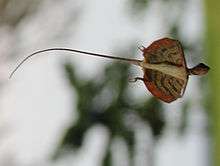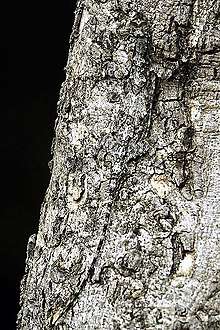Draco (genus)
Draco is a genus of agamid lizards that are also known as flying lizards, flying dragons or gliding lizards. These lizards are capable of gliding flight; their ribs and their connecting membrane may be extended to create "wings" (patagia), the hindlimbs are flattened and wing-like in cross-section, and a flap on the neck (the gular flag) serves as a horizontal stabilizer and are sometimes used in warning to others. Draco are arboreal insectivores.
| Draco | |
|---|---|
 | |
| D. taeniopterus in mid-glide, on Bulon Island, Thailand | |
| Male D. spilonotus extending the gular flag (throat flap) and patagia ("wings") in Sulawesi, Indonesia | |
| Scientific classification | |
| Kingdom: | Animalia |
| Phylum: | Chordata |
| Class: | Reptilia |
| Order: | Squamata |
| Suborder: | Iguania |
| Family: | Agamidae |
| Subfamily: | Draconinae |
| Genus: | Draco Linnaeus, 1758 |
| Species | |
|
See text | |
While not capable of powered flight they often obtain lift in the course of their gliding flights. Glides as long as 60 m (200 ft) have been recorded, over which the animal loses only 10 m (33 ft) in height, which is quite some distance, considering that one lizard is only around 20 cm (7.9 in) in total length, tail included.[1] They are found in South Asia and Southeast Asia, and are fairly common in forests, areca gardens, teak plantations and shrub jungle.
Etymology
Carl Linnaeus derived the name of this genus from the Latin term for mythological dragons.
Gliding
The lizards are well known for their "display structures" and ability to glide long distances using their wing-like, patagial membranes supported by elongated thoracic ribs to generate lift forces.[2] The India flying lizard is capable of gliding from tree to tree found in the Western Ghats and hill forests of southern India. The flying dragon lizard avoids danger by opening two large winglike flaps of skin and steers, brakes with its tail.[3]
Species


The following 42 species are recognized:[4][5]
- Draco abbreviatus Hardwicke & Gray, 1827
- Draco affinis Bartlett, 1895
- Draco beccarii W. Peters & Doria, 1878[6]
- Draco biaro Lazell, 1987
- Draco bimaculatus Günther, 1864
- Draco blanfordii Boulenger, 1885
- Draco boschmai Hennig, 1936
- Draco bourouniensis Lesson, 1834
- Draco caerulhians Lazell, 1992
- Draco cornutus Günther, 1864
- Draco cristatellus Günther, 1872
- Draco cyanopterus W. Peters, 1867
- Draco dussumieri A.M.C. Duméril & Bibron, 1837
- Draco fimbriatus Kuhl, 1820
- Draco formosus Boulenger, 1900
- Draco guentheri Boulenger, 1885
- Draco haematopogon Gray, 1831
- Draco indochinensis M.A. Smith, 1928
- Draco iskandari McGuire et al., 2007
- Draco jareckii Lazell, 1992
- Draco lineatus Daudin, 1802
- Draco maculatus (Gray, 1845)
- Draco maximus Boulenger, 1893
- Draco melanopogon Boulenger, 1887
- Draco mindanensis Stejneger, 1908
- Draco modiglianii Vinciguerra, 1892
- Draco norvillii Alcock, 1895
- Draco obscurus Boulenger, 1887
- Draco ornatus (Gray, 1845)
- Draco palawanensis McGuire & Alcala, 2000
- Draco quadrasi Boettger, 1893
- Draco quinquefasciatus Hardwicke & Gray, 1827
- Draco reticulatus Günther, 1864
- Draco rhytisma Musters, 1983
- Draco spilonotus Günther, 1872
- Draco spilopterus Wiegmann, 1834
- Draco sumatranus Schlegel, 1844
- Draco supriatnai McGuire et al., 2007
- Draco taeniopterus Günther, 1861
- Draco timoriensis Kuhl, 1820
- Draco volans Linnaeus, 1758
- Draco walkeri Boulenger, 1891
Nota bene: a binomial authority in parentheses indicates that the species was originally described in a genus other than Draco.
Reproduction
The only time a female flying lizard ventures to the ground is when she is ready to lay her eggs. She descends the tree she is on and makes a nest hole by forcing her head into the soil. She then lays 2–5 eggs before filling the hole and guards the eggs for approximately 24 hours, but then leaves and has nothing more to do with her offspring.[1]
In fiction
Draco dussumieri features prominently in Poornachandra Tejaswi's Kannada novel Carvalho (ಕರ್ವಾಲೊ, Karvālǒ). In this story, middle aged scientist Carvalho, searches for this flying lizard (considered very rare in this novel) in the forests of the Western Ghats in the Indian state of Karnataka, and finally the lizard flies down a steep cliff off thick forest.
The titular monster from Toho's 1958 film "Varan the Unbelievable" is based on that of a Draco lizard.
See also
- Flying and gliding animals
- Xianglong, extinct Cretaceous lizards that glided using their ribs
- Mecistotrachelos
- Kuehneosauridae
- Chrysopelea
References
- Piper, Ross (2007). 'Extraordinary Animals: An Encyclopedia of Curious and Unusual Animals'. Santa Barbara, California: Greenwood Press.
- Herre, Albert W. (1958). "On the Gliding of Flying Lizards, Genus Draco ". Copeia. 1958 (4): 338–339. doi:10.2307/1439979. JSTOR 1439979.
- http://www.walkthroughindia.com/wildlife/the-6-rare-species-of-reptiles-in-india/
- Draco. The Reptile Database. www.reptile-database.org.
- "Draco ". Dahms Tierleben. www.dahmstierleben.de.
- Beolens, Bo; Watkins, Michael; Grayson, Michael (2011). The Eponym Dictionary of Reptiles. Baltimore: Johns Hopkins University Press. xiii + 296 pp. ISBN 978-1-4214-0135-5. (Draco beccarii, p. 21).
Further reading
| Wikimedia Commons has media related to Draco. |
| Wikispecies has information related to Draco |
- Goin CJ, Goin OB, Zug GR (1978). Introduction to Herpetology, Third Edition. San Francisco: W.H. Freeman & Company. xi + 378 pp. ISBN 0-7167-0020-4. (Genus Draco, pp. 41, 86, 112, 279, 288).
- Inger RF (1983). Morphological and ecological variation in the flying lizards (Genus Draco). Chicago: Field Museum of Natural History. (Fieldiana Zoology, New Series, No. 18). 33 pp.
- Linnaeus C (1758). Systema naturæ per regna tria naturæ, secundum classes, ordines, genera, species, cum characteribus, diferentiis, synonymis, locis. Tomus I. Editio Decima, Reformata. Stockholm: L. Salvius. 824 pp. (Genus Draco, p. 199).
- McGuire JA, Dudley R (2011). "The Biology of Gliding in Flying Lizards (Genus Draco) and their Fossil and Extant Analogs". Integrative and Comparative Biology. 51 (6): 983–90. doi:10.1093/icb/icr090. PMID 21798987.
_(14136387745).jpg)